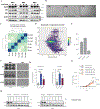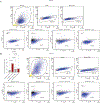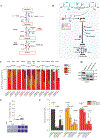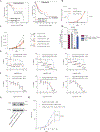Inhibition of the proline metabolism rate-limiting enzyme P5CS allows proliferation of glutamine-restricted cancer cells
- PMID: 37957387
- PMCID: PMC11639397
- DOI: 10.1038/s42255-023-00919-3
Inhibition of the proline metabolism rate-limiting enzyme P5CS allows proliferation of glutamine-restricted cancer cells
Abstract
Glutamine is a critical metabolite for rapidly proliferating cells as it is used for the synthesis of key metabolites necessary for cell growth and proliferation. Glutamine metabolism has been proposed as a therapeutic target in cancer and several chemical inhibitors are in development or in clinical trials. How cells subsist when glutamine is limiting is poorly understood. Here, using an unbiased screen, we identify ALDH18A1, which encodes P5CS, the rate-limiting enzyme in the proline biosynthetic pathway, as a gene that cells can downregulate in response to glutamine starvation. Notably, P5CS downregulation promotes de novo glutamine synthesis, highlighting a previously unrecognized metabolic plasticity of cancer cells. The glutamate conserved from reducing proline synthesis allows cells to produce the key metabolites necessary for cell survival and proliferation under glutamine-restricted conditions. Our findings reveal an adaptive pathway that cancer cells acquire under nutrient stress, identifying proline biosynthesis as a previously unrecognized major consumer of glutamate, a pathway that could be exploited for developing effective metabolism-driven anticancer therapies.
© 2023. The Author(s), under exclusive licence to Springer Nature Limited.
Conflict of interest statement
Competing interests:
Authors declare no competing interests.
Figures












References
-
- Bott J, Peng I-C, Fan Y, Faubert B, Zhao L, Li J, Neidler S, Sun Y, Jaber N, Krokowski D, Lu W, Pan J-A, Powers S, Rabinowitz J, Hatzoglou M, Murphy DJ, Jones R, Wu S, Girnun G, Zong W-X, Oncogenic Myc Induces Expression of Glutamine Synthetase through Promoter Demethylation. Cell Metab 22, 1068–77 (2015). - PMC - PubMed
MeSH terms
Substances
Grants and funding
LinkOut - more resources
Full Text Sources
Medical
Molecular Biology Databases
Miscellaneous

